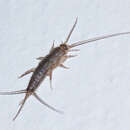en
names in breadcrumbs


Thysanura is an order of insects, encompassing silverfish and firebrats, best known for their three long caudal filaments. The name Thysanura is derived from the Greek θυσάνος, thysanos for fringe, tassel, bristle and ουρα, oura for tail, a reference to the three fanned out caudal filaments.
The families Machilidae and Meinertellidae of the jumping bristletails were once included with Thysanura. Occasionally, the correspondingly restricted order Thysanura is referred to as Zygentoma.
Silverfish are so called due to the silvery glitter of the scales covering their bodies. Their movement is "fish-like" and makes it look as if they are swimming. They are less than 1 centimetre (0.39 in) long, and found in damp corners or amongst books and paper in houses.
Silverfish have flattened bodies and may be elongated or oval in shape. They have flexible antennae and small or absent compound eyes. They have short mandibles and relatively unspecialised mouthparts. Many species also have a number of short appendages on their abdominal segments, but the most distinctive feature of the group is the presence of three long, tail-like filaments extending from their last segment. The two lateral filaments are formed from the abdominal cerci (Hoell et al. 1998).
Silverfish have an elaborate courtship ritual to ensure exchange of sperm. The male spins a silken thread between the substrate and a vertical object. He deposits a sperm packet (spermatophore) beneath this thread and then coaxes a female to walk under the thread. When her cerci contact the silk thread, she picks up the spermatophore with her genital opening. Sperm are released into her reproductive system, and then she ejects the empty spermatophore and eats it.
Silverfish continue to moult throughout their life, with several sexually mature instars, unlike the pterygote insects. They are relatively slow growing, and lifespans of up to four years have been recorded (Hoell et al. 1998).
Order Zygentoma is also known as Order Thysanura.They are distributed worldwide.About 320 species have been described.The common names for the species are silverfish and firebrats.They get their name from the silver scales on some of the species.Their distinguishing characteristic is their three caudal filaments.They do not have wings.Silverfish are about two to twenty millimeters in length.They can either be found indoors amongst books or outdoors under stones, bark, or fungi.Outdoor silverfish feed on plant materials and indoor silverfish feed on wallpaper glue or book binding paste.Young silverfish will usually molt between twenty to seventy times.The molts only make them larger in size.They live for about one to four years.They can be found in the fossil record as far back as the Late Carboniferous.
Thysanura is the now deprecated name of what was, for over a century, recognised as an order in the class Insecta. The two constituent groups within the former order, the Archaeognatha (jumping bristletails) and the Zygentoma (silverfish and firebrats), share several characteristics, such as of having three long caudal filaments, the lateral ones being the cerci, while the one between (telson) is a medial cerciform appendage, specifically an epiproct. They are also both wingless, and have bodies covered with fine scales, rather like the scales of the practically unrelated Lepidoptera. In the late 20th century, it was recognized that the two suborders were not sister taxa, therefore Thysanura was paraphyletic, and the two suborders were each raised to the status of an independent monophyletic order, with Archaeognatha sister taxon to the Dicondylia, including the Zygentoma.[1][2]

Although the group Thysanura is no longer recognized, the name still appears in some published material.[3] Another name used to separate the two groups from winged insects is Apterygota.
The name Thysanura, first applied to the group by Pierre André Latreille,[4] was derived from the Greek θυσάνος, thysanos for fringe, tassel, bristle and οὐρά, oura for "tail", a reference to the three fanned out caudal filaments. This etymology is consistent with the English word "bristletail", which is the common name for several hexapod species, not all of which fell within Thysanura.[5]
Thysanura is the now deprecated name of what was, for over a century, recognised as an order in the class Insecta. The two constituent groups within the former order, the Archaeognatha (jumping bristletails) and the Zygentoma (silverfish and firebrats), share several characteristics, such as of having three long caudal filaments, the lateral ones being the cerci, while the one between (telson) is a medial cerciform appendage, specifically an epiproct. They are also both wingless, and have bodies covered with fine scales, rather like the scales of the practically unrelated Lepidoptera. In the late 20th century, it was recognized that the two suborders were not sister taxa, therefore Thysanura was paraphyletic, and the two suborders were each raised to the status of an independent monophyletic order, with Archaeognatha sister taxon to the Dicondylia, including the Zygentoma.
 A typical member of the order Archaeognatha
A typical member of the order Archaeognatha Although the group Thysanura is no longer recognized, the name still appears in some published material. Another name used to separate the two groups from winged insects is Apterygota.